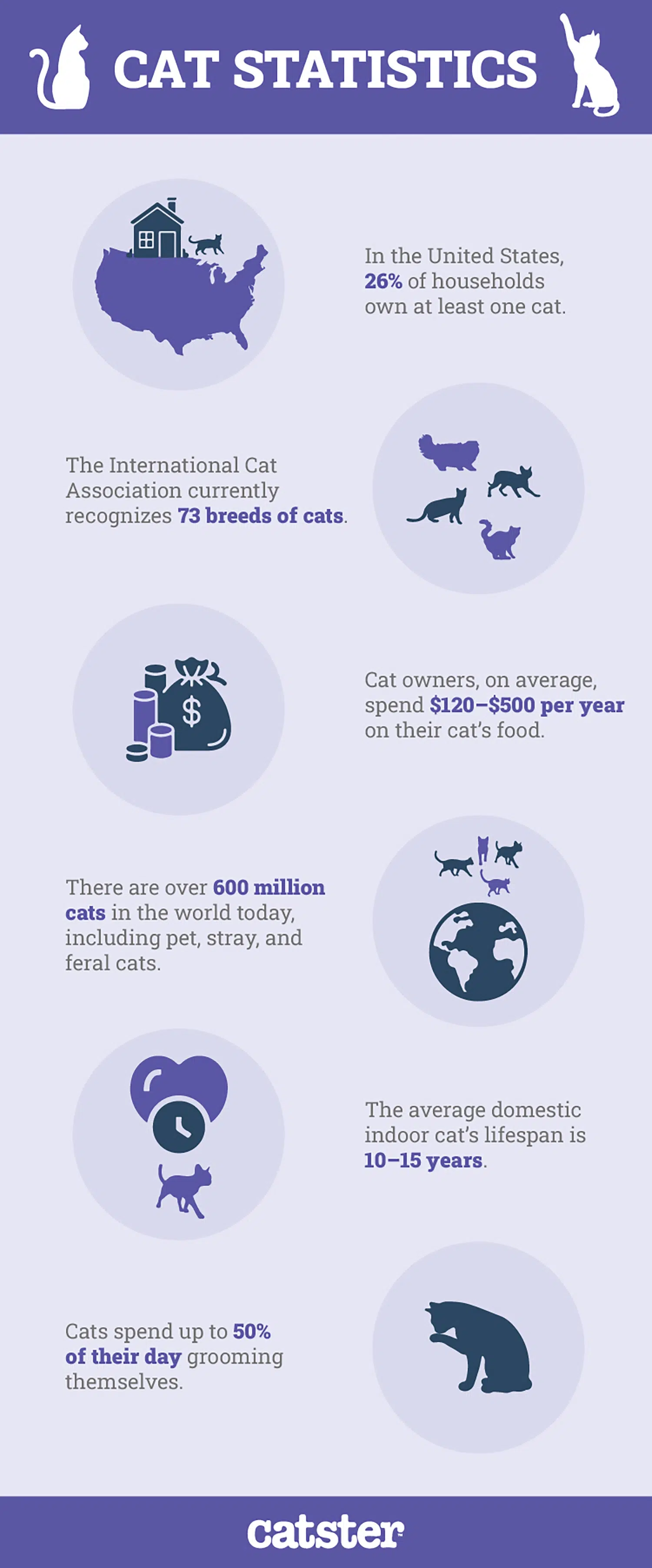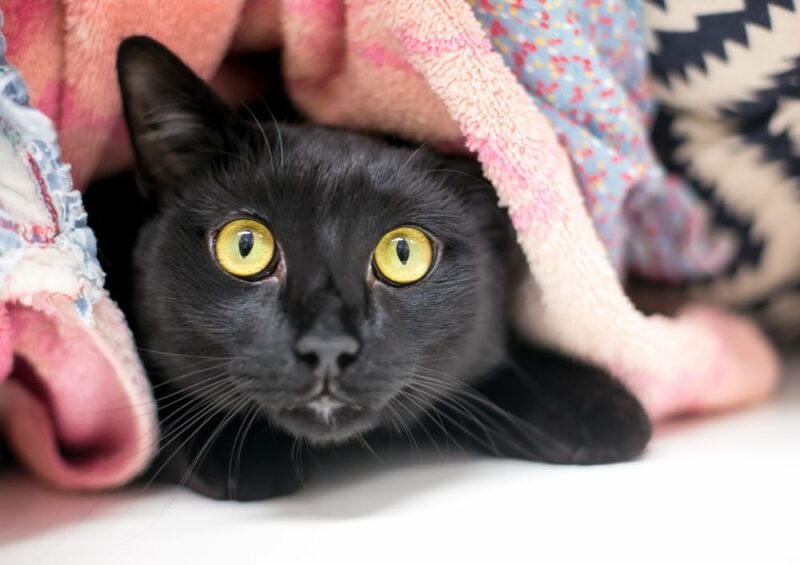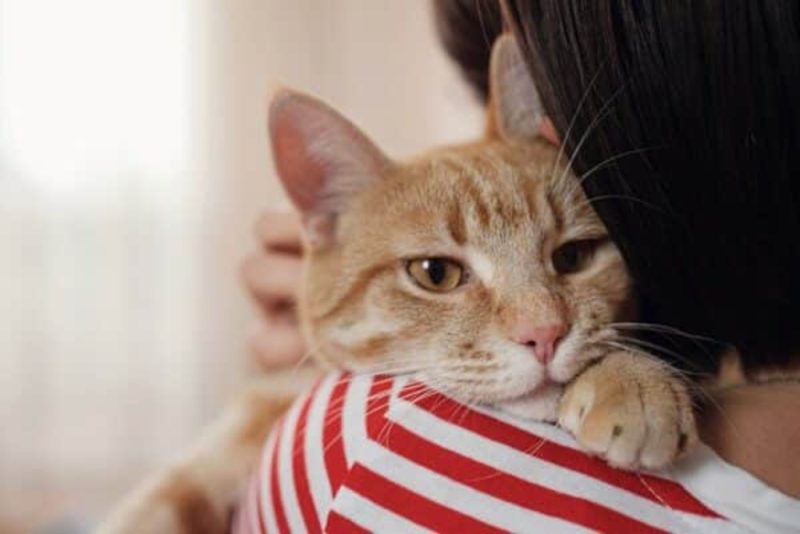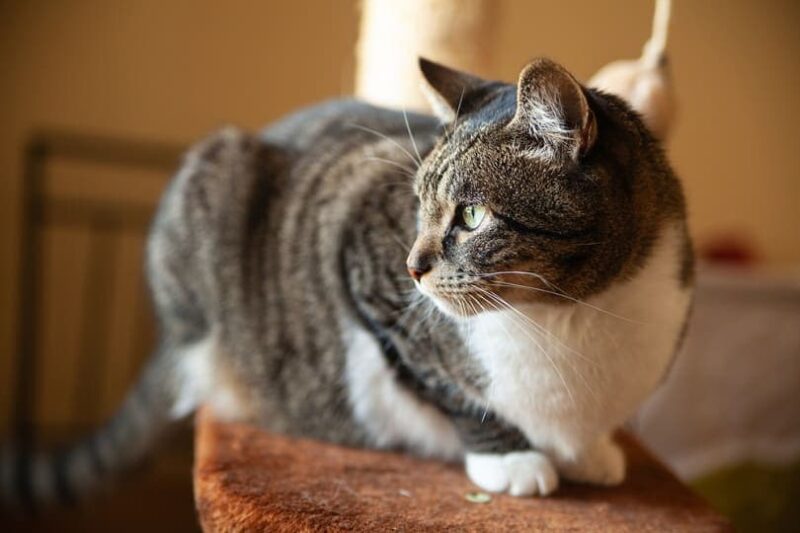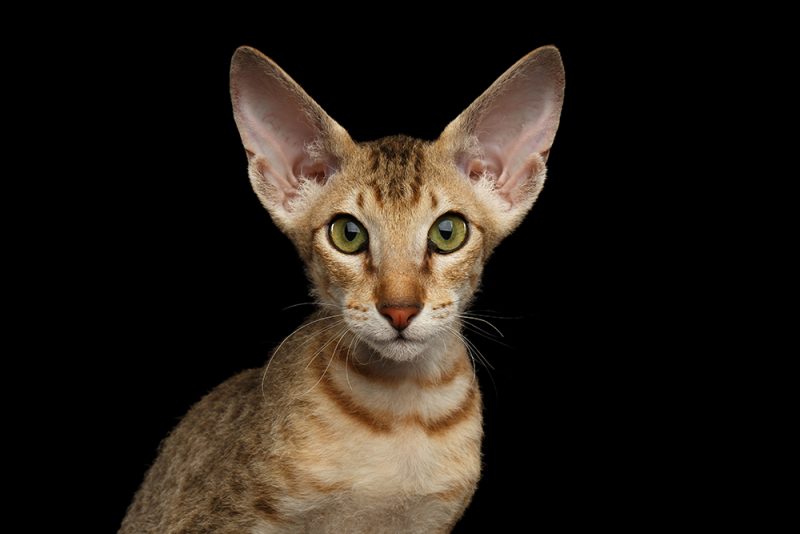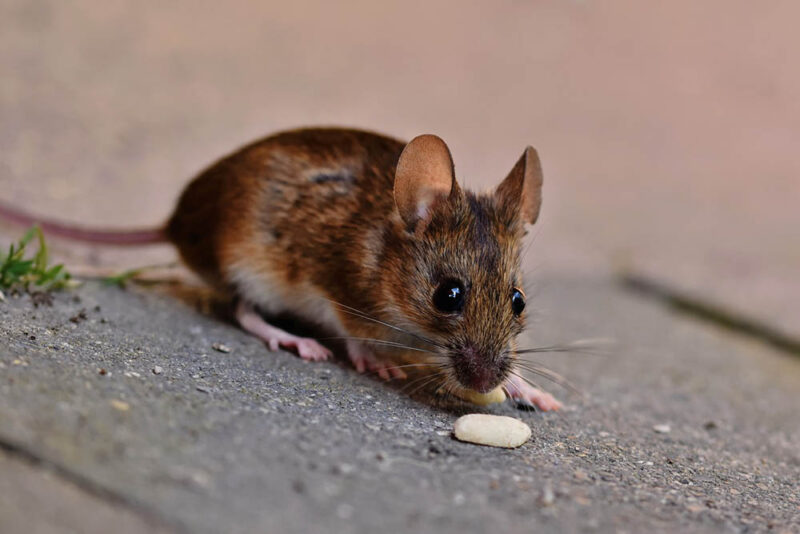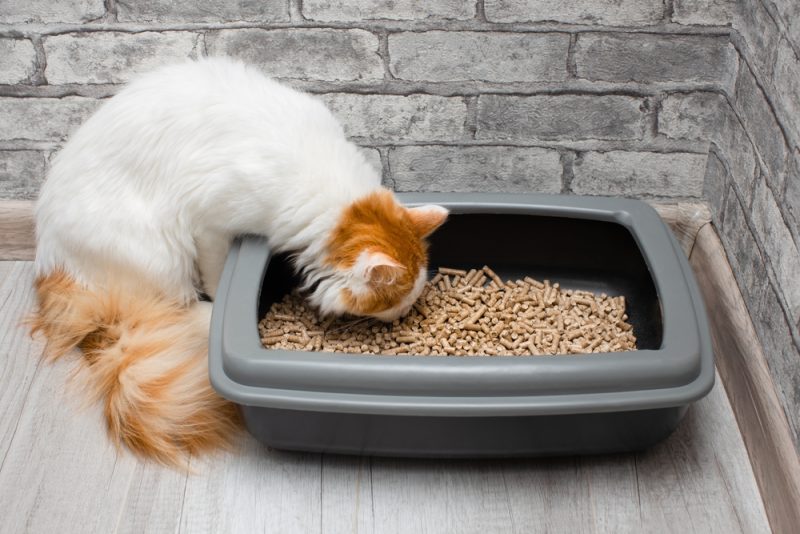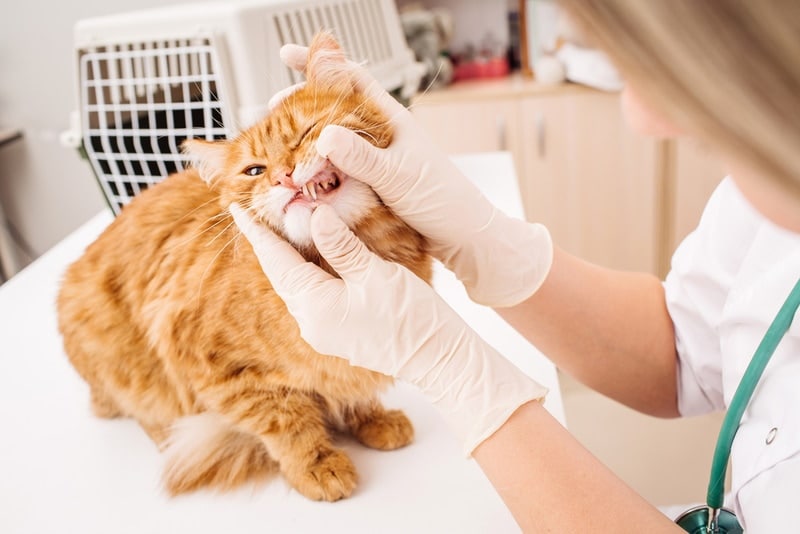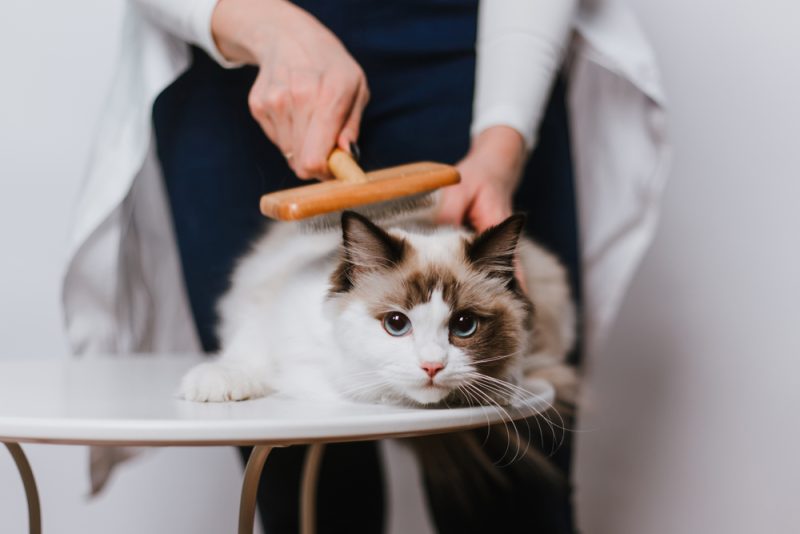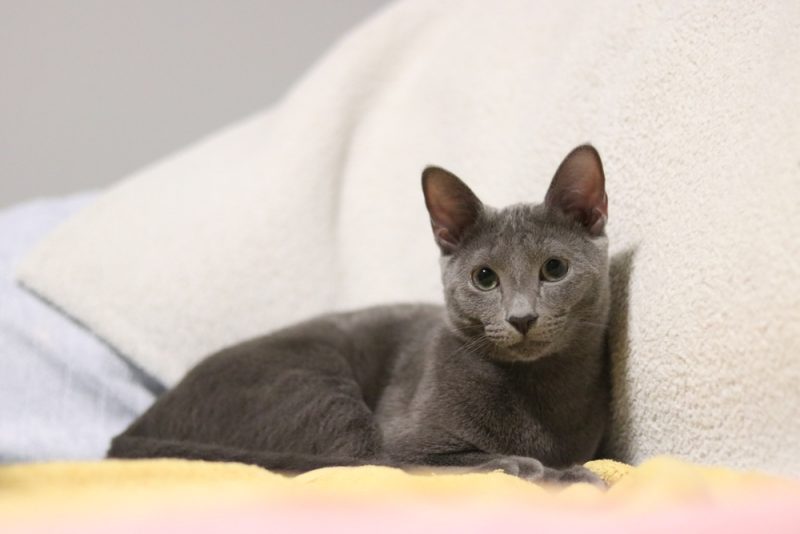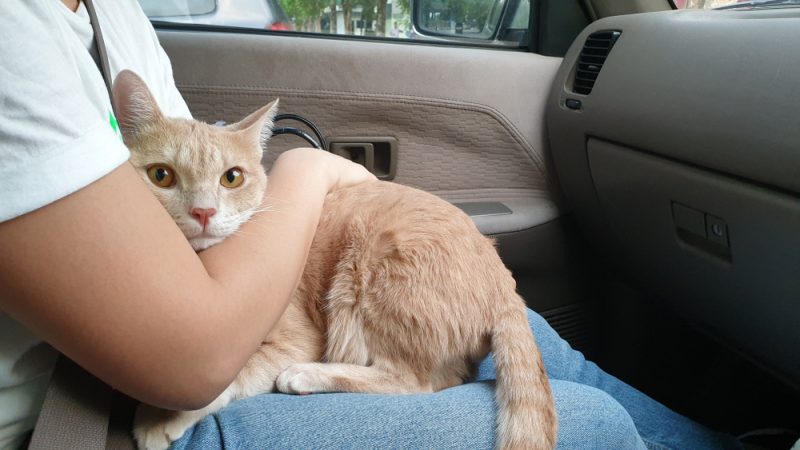In this article
View 4 More +Note: This article’s statistics come from third-party sources and do not represent the opinions of this website.
It’s amazing how many cat lovers there are in the world. To prove how much people love their feline companions, we filled this article with 15 cat statistics and facts. Even if you consider yourself a cat lover, you may be surprised at a few of these interesting bits of information. Cats never cease to amaze us! Read on to learn more about their lives around the world.

Top 15 Cat Statistics
- In the United States, 26% of households own at least one cat.
- There are approximately 82 million pet cats in the U.S.
- In the European Union, Germany owns the most cats, with 24% of households having at least one pet feline.
- The International Cat Association currently recognizes 73 breeds of cats.
- Only 3% of cat owners in the U.S. get their cats from breeders.
- The COVID-19 pandemic led to a 40% increase in cat ownership in the United States.
- Cat owners, on average, spend $120–$500 per year on their cat’s food.
- Only 64% of lost cats that wind up in animal shelters are reunited with their owners.
- Approximately 2.1 million cats are adopted each year from shelters.
- Around 530,000 cats are euthanized in shelters each year.
- An estimated 60–100 million cats in the U.S. live on the street without a home.
- There are over 600 million cats in the world today, including pet, stray, and feral cats.
- The average domestic indoor cat’s lifespan is 10–15 years.
- Heart disease is the leading cause of sudden death in cats.
- Cats spend up to 50% of their waking hours grooming themselves.


Cat Ownership Statistics
1. In the United States, 26% of households own at least one cat.
(AVMA)
Many of these cats are mixed breeds. Most cat owners in the United States adopt their cats from shelters and rescue or get them from friends and family members. People are also likely to rescue a stray cat from the street and add them to their household. It’s much more common for people to purchase dogs rather than cats from breeders.
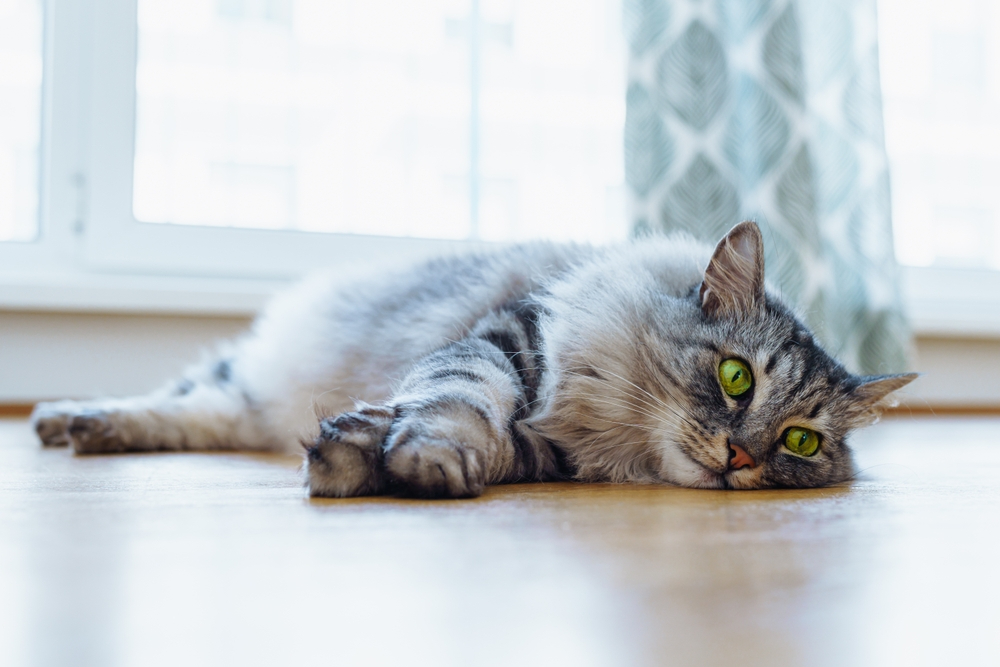
2. There are approximately 82 million pet cats in the U.S.
(Alley Cat Allies)
One in three households in the United States owns a cat. There is an average of 2.2 cats per cat household, so many people have more than one feline companion.
3. In the European Union, Germany owns the most cats, with 24% of households having at least one pet feline.
(Statista)
The pet cat population in Germany doesn’t include strays, which could be as high as 2 million. Efforts are underway to spay and neuter as many stray cats as possible in Germany. Cats are important to German cat owners, often taking the place of a partner or child in their lives. Cats provide balance in the lives of busy people and enhance their owners’ quality of life.
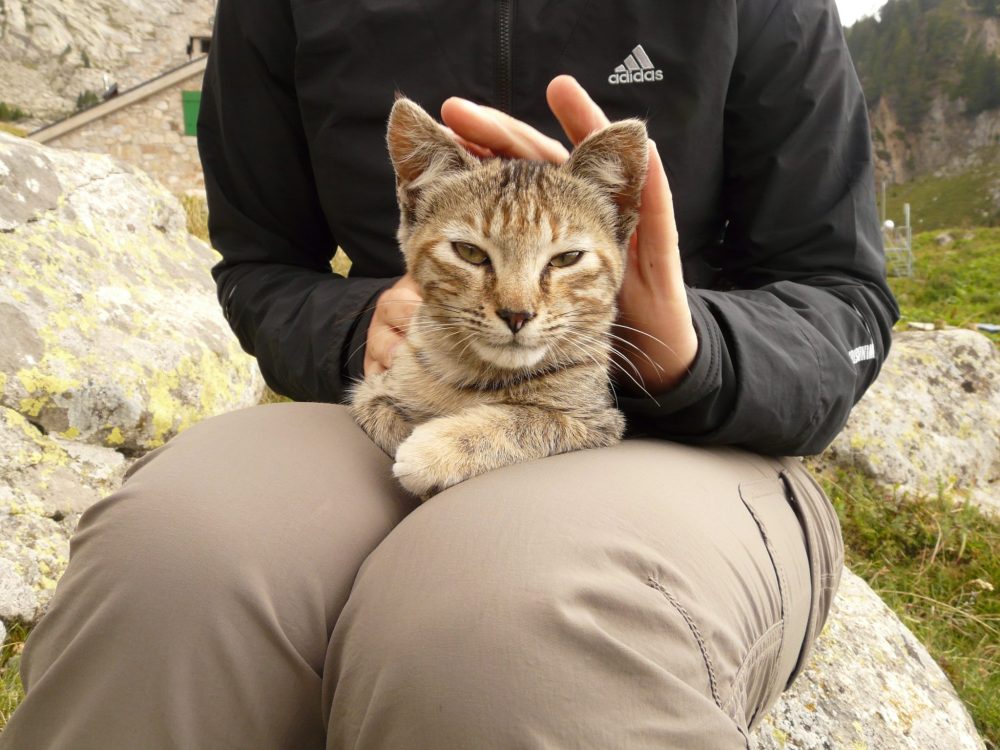
4. The International Cat Association currently recognizes 73 breeds of cats.
(TICA)
These breeds are recognized as pedigreed cats for championship competitions. This number can change regularly as new breeds are developed and introduced.
5. Only 3% of cat owners in the U.S. get their cats from breeders.
(ASPCA)
Around 27% of American cat households have obtained their cats by taking them in off the street as strays. 31% of cat owners get their cats from an animal shelter or humane society. Only 3% of cats in the country come from breeders, which might be because cats multiply so often and so quickly. They are easier and cheaper to acquire than puppies.
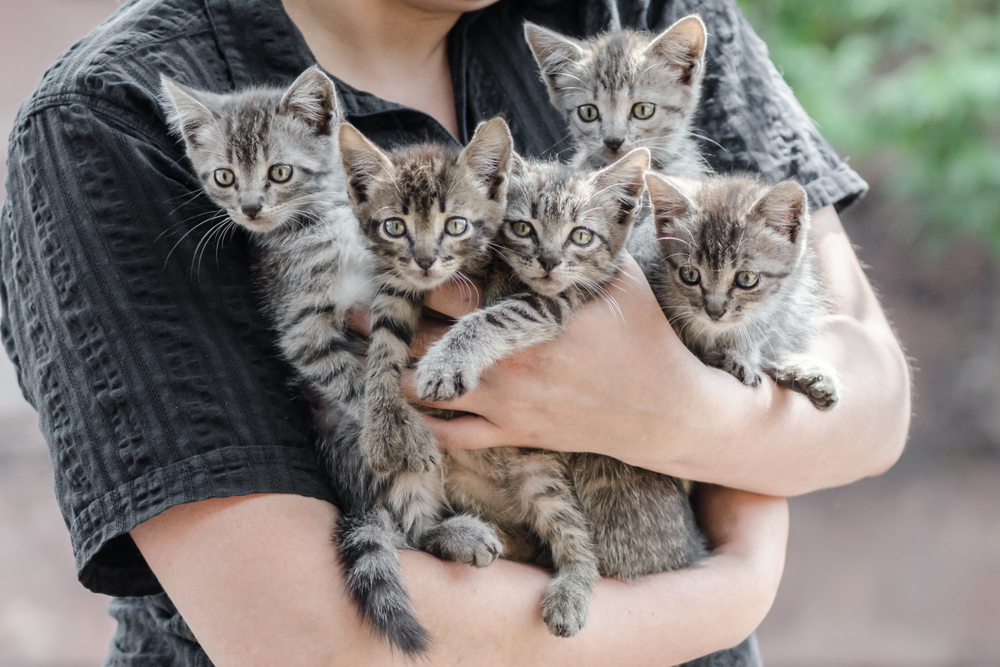
6. The COVID-19 pandemic led to a 40% increase in cat ownership in the United States.
(HumanePro)
The COVID-19 pandemic influenced 40% of new cat owners to acquire a cat. Of that percentage, 49% of these new owners were male, 33% were female, and 56% were millennials.
7. Cat owners, on average, spend $120–$500 per year on their cat’s food.
(Bankrate)
Other recurring expenses that come with cat ownership are vet visits, vaccines, grooming, flea-and-tick prevention, treats, toys, and pet sitting/boarding.
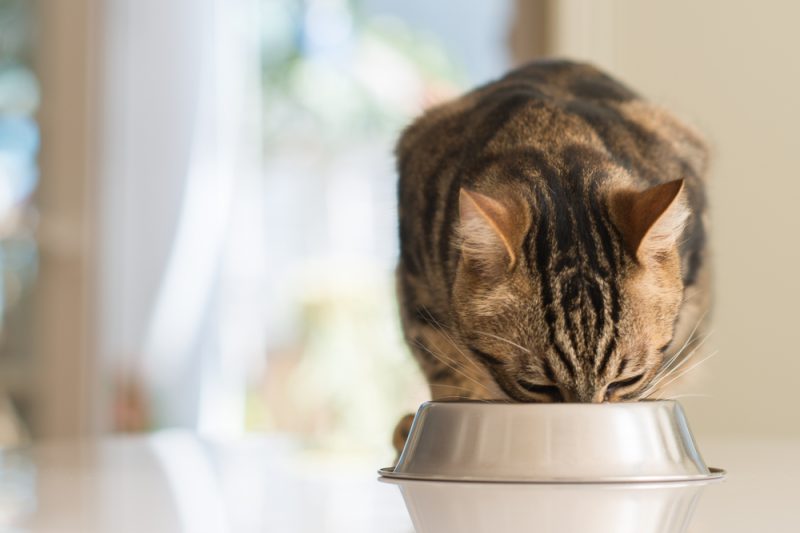

Shelter Cat Statistics
8. Only 64% of lost cats that wind up in animal shelters are reunited with their owners.
(PetMD)
Around 1/3 of missing cats find their own way back home during the first week. Making sure that your cat is microchipped and that the information is current is a good way to increase the chances of being reunited should they go missing.
9. Approximately 2.1 million cats are adopted each year from shelters.
(ASPCA)
This may seem like a high number, but hundreds of thousands of cats are still euthanized each year in shelters. Due to an increase in awareness of spaying and neutering and adopting instead of buying pets, this number has decreased. In 2011, 2.6 million dogs and cats were euthanized in shelters. It has decreased to 920,000 dogs and cats a year.
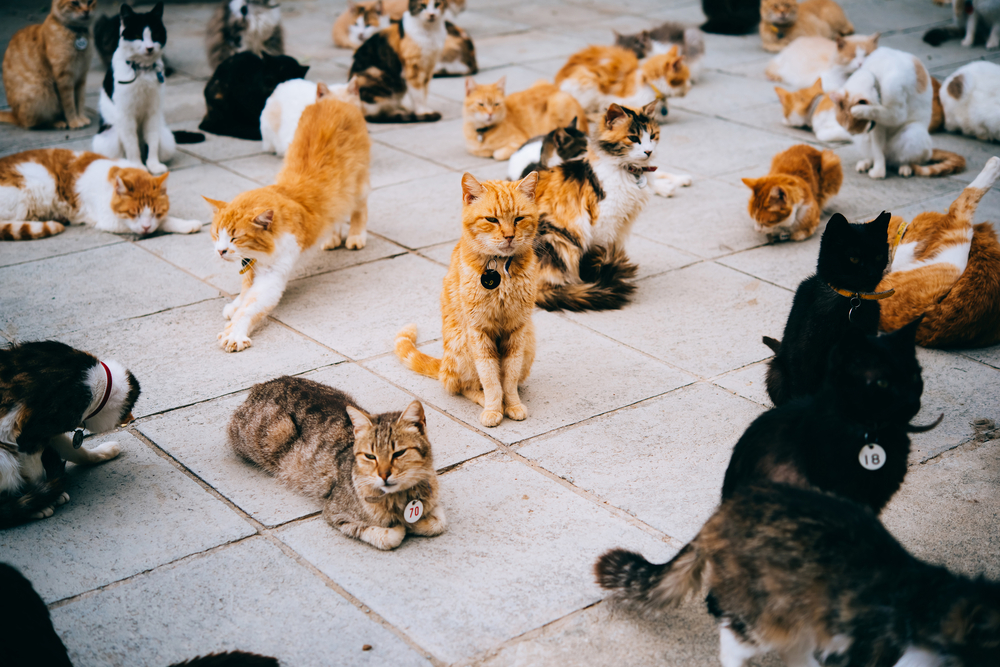
10. Around 530,000 cats are euthanized in shelters each year.
(ASPCA)
While the number has decreased over the years, this is still an exceptionally high number of animals killed each year just because there aren’t enough homes for them. Spaying and neutering your cats, keeping them indoors, and making sure they’re microchipped with up-to-date information will lead to a further decrease in this number.

Feral Cat Statistics
11. An estimated 60–100 million cats in the US live on the street without a home.
(PETA)
Street life for domesticated cats can be miserable. In addition to the spread of diseases that can prematurely end their lives, they face starvation, dehydration, and a lack of shelter from the elements. They are constantly in a fight to survive. Even feral cats tend to rely on humans for food and water. They’re still domesticated and are not native wild animals. The number of street cats can be decreased through Trap, Neuter, Return efforts that sterilize feral cats to prevent them from breeding.
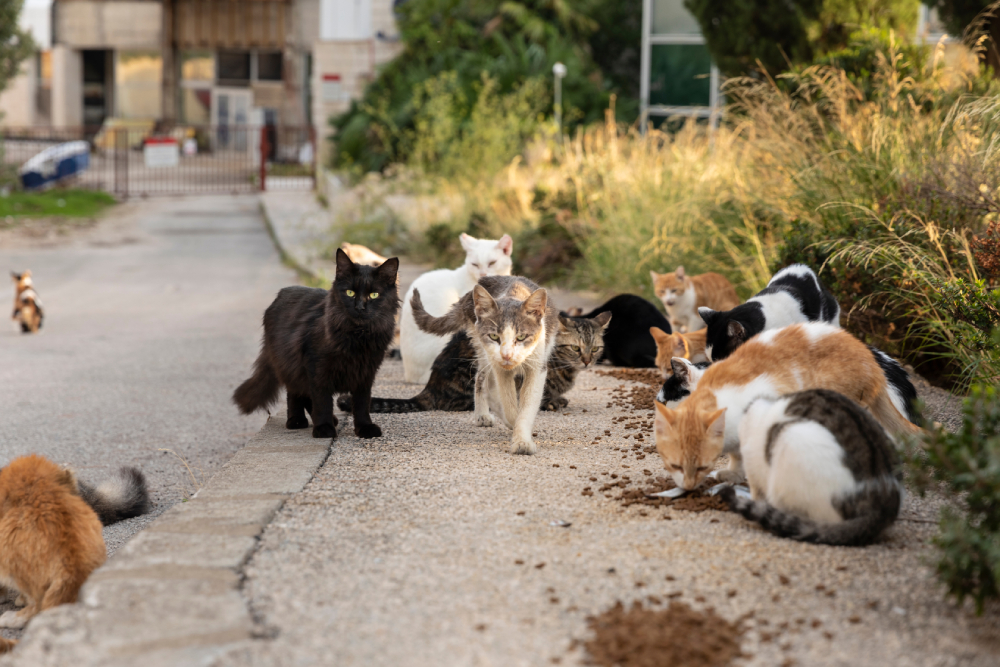
12. There are over 600 million cats in the world today, including pet, stray, and feral cats.
(World Atlas)
Out of those 600 million, approximately 373 million are kept as pets. This number can vary because of the difficulty in tracking feral cats around the world.

Cat Health Statistics
13. The average domestic indoor cat’s lifespan is 10–15 years.
(PetMD)
Cats that spend a great deal of unsupervised time outdoors have their life expectancy cut in half, typically only living around 7 years. Strictly indoor cats can live until they are 14 or 15 in relatively good health. Cats that live outside usually only live 2–4 years.
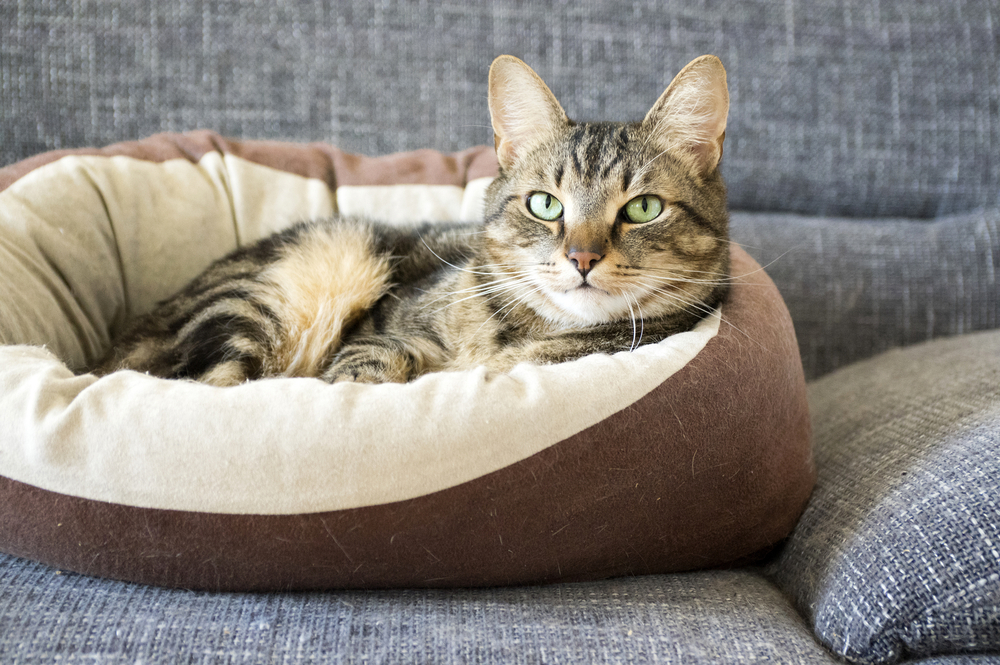
14. Heart disease is the leading cause of sudden death in cats.
(Pet Health Network)
Heart disease in cats is usually caused by feline cardiomyopathy or heartworm disease. These conditions don’t always show warning signs, and cats can suddenly collapse without much that can be done to save them. To keep your cat as healthy as possible, feed them a healthy diet and visit the vet regularly for checkups.
15. Cats spend up to 50% of their waking hours grooming themselves.
(Cornell)
Cats are fastidious groomers and like to stay clean. This can also mean they experience hairballs too. Grooming is normal unless you see signs of hair loss. If bald patches or skin lesions occur, contact your vet.
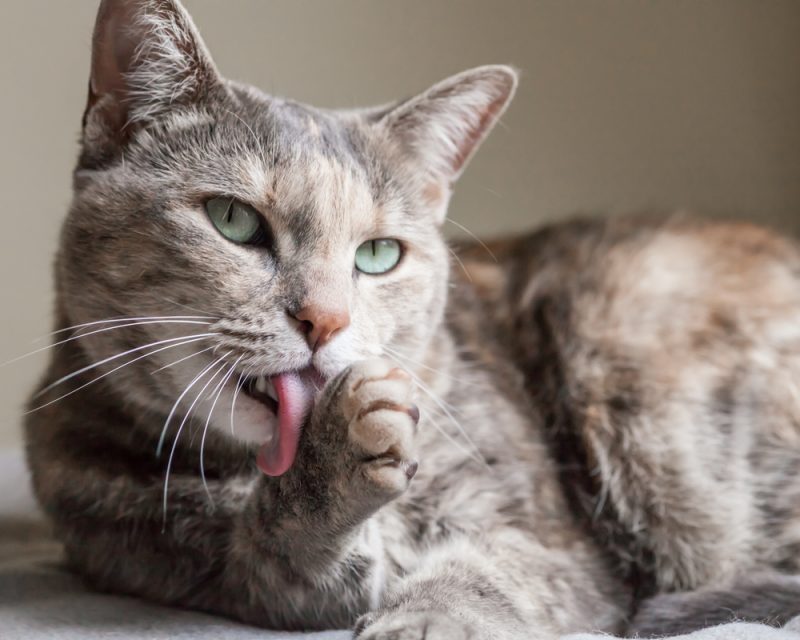

Frequently Asked Questions About Cats
How many kittens do unaltered cats produce?
Unspayed and unneutered cats can produce thousands of kittens in their lifetimes. This adds to the overpopulation of cats and the number of those that are euthanized each year simply because there are not enough homes for them all. If one female and one male cat mate twice a year and produce 2.8 kittens with each litter, in 8 years, they and their offspring will have created 2,072,514 cats. To reduce the number of homeless cats, make sure to have your own cat spayed or neutered as soon as possible before they start to create litters. (North Shore Animal League)
How often should cats visit the veterinarian?
Ideally, your cat should see the vet every 6–12 months. Your vet will want to see your kitten more regularly for the proper vaccination protocols and parasite treatments. Adult cats should receive preventative care through exams, parasite treatments, and bloodwork. Senior cats should see the vet twice a year to keep in good health. If any health conditions should arise during any stage of your cat’s life, regular vet visits to monitor your cat’s health are the way to diagnose and treat them as soon as possible. (AAHA).
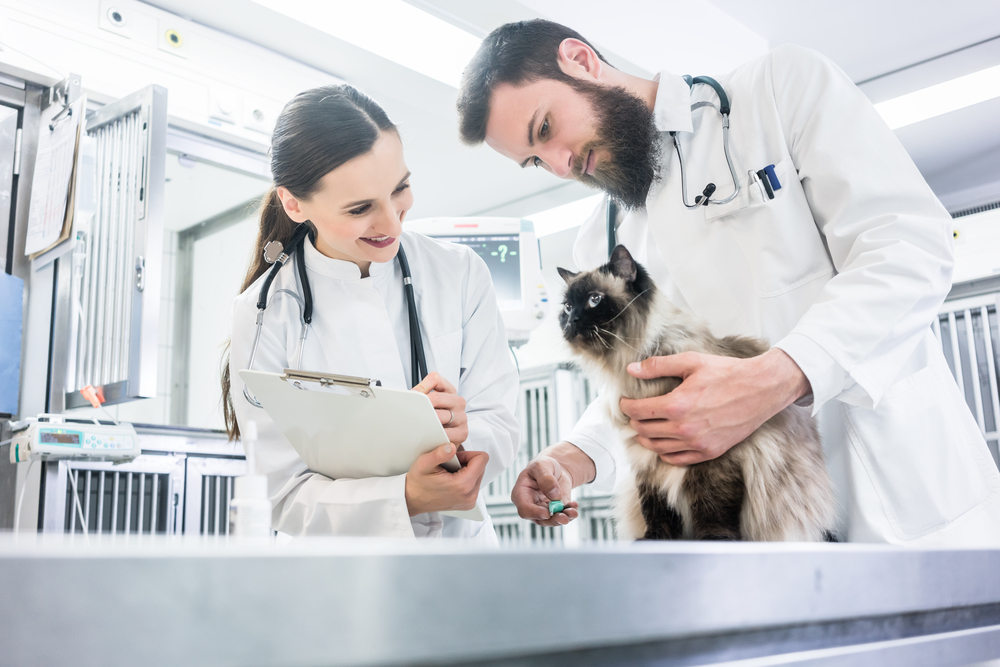
Why can’t domestic cats roar like large, wild cats?
Only lions, tigers, leopards, and jaguars can roar. Instead of an epihyal bone in their voice boxes, they have ligaments. These ligaments stretch, helping the cats create a larger sound passage with pitch variation. As the ligament stretches further, the sound emitting from the cat becomes lower. Interestingly, cats can either purr or roar. This means roaring cats can’t purr and purring cats can’t roar. (Discover Wildlife)
Can cats be vegans?
Cats are obligate carnivores. This means they require meat from animal sources in their diet to survive. Meat products make up the majority of all commercial cat food to provide pet cats with the nutrition that they need to stay healthy. Some of the nutrients that cats need can’t be made naturally in their bodies or obtained through plant matter. Taurine, arachidonic acid, and several other nutrients that are necessary for their health must be obtained through animal meat and meat by-products, as these are not found in plant matter.
If cats don’t eat meat in their diet, they could become lethargic, have convulsions, develop a weakened immune system, and go blind before eventually dying from lack of nutrition. Cats cannot be vegetarians or vegans, even if their owners are. (Island Pet Vet)
What does it mean when a cat is in heat?
Only intact female cats go into heat (assuming that certain criteria are met), which refers to the estrous cycle, a period of time when a female will try to lure male cats to her location and eventually be receptive to mating. During this time, she may become overly affectionate, pace continuously, attempt to escape, and yowl incessantly to attract a mate. The way to stop a cat from having heat cycles is to have her spayed. (Wild Animal Park).

Conclusion
Cat owners know that their feline friends are just as lovable and important as any other pets. If you’re new to cat ownership or are considering adding a cat to your household, we hope that these cat statistics have answered a few of your questions and have helped you decide on the right pet for you.
You may also be interested in:
Featured Image Credit: Elisa Putti, Shutterstock

